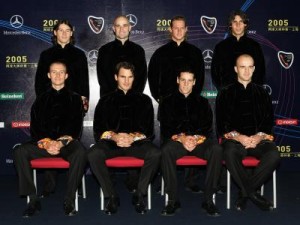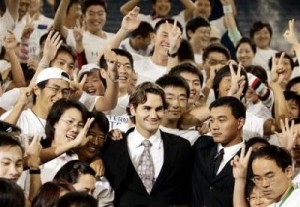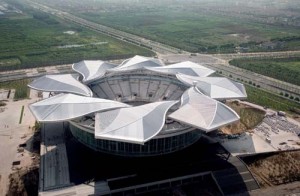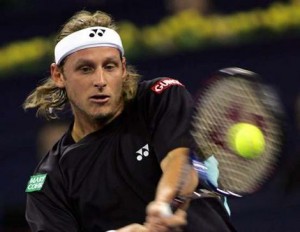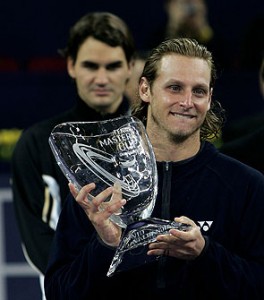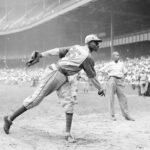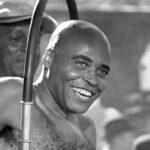Classic Match: David Nalbandian Vs. Roger Federer at Tennis Masters Cup in 2005
In 2005 the venue for the Tennis Masters Cup Final—the ATP’s year-end championship—moved to Shanghai from Houston.
Awarding China the honor of hosting the event was a coup—a great step forward in promoting professional tennis to millions of new tennis fans.
The Chinese, increasingly enamored of men’s professional tennis, especially the play of Roger Federer, the current world No. 1, felt pride in providing the best possible environment for the players.
Problems, however, facing the ATP and the sponsors of the event to be held in Qi Zhong City Arena for the first time had nothing to do with the Arena or any physical accommodations.
As the tournament neared, No. 2 Rafael Nadal pulled out of the competition following the withdrawal of No. 3 Andy Roddick—both citing injuries.
Also sidelined for the event was No. 4 Lleyton Hewitt. No. 5 Andre Agassi along with Marat Safin, winner of the 2005 Australian Open, also pulled out of the round robin competition.
The majority of the eight top-ranked men were unable to compete.
Somewhat reluctantly, Roger Federer came to Shanghai after a six-week layoff nursing a right ankle injury. He’d sported crutches only three-weeks prior to the start of the tournament.
The Swiss felt pressure to play as most of the top eight sat hobbled, unable to compete.
The success of the tournament seemed to depend on Federer, allowing the hosts to save face by featuring matches with the World No. 1 in action.
Needless to say, Federer was not match strong or in the best of shape after his long lay-off. He committed to play understanding, however, that his chances to win were slim because this event did not allow him the opportunity to “play his way in.”
Federer also entered this tournament hoping for a chance to equal John McEnroe’s record for best winning percentage for a season.
In 1984, McEnroe won 82 matches, losing only three. Astounding. By 2005, that record had stood for over 21 years.
The Swiss hoped to match McEnroe’s feat because so far on the season, Federer had lost only three matches.
The Swiss lost to Marat Safin during the semifinals at the 2005 Australian Open. Later on clay Federer lost in the quarterfinals at the Monte Carlo Masters to Frenchman Richard Gasquet.
Federer also fell victim to Rafael Nadal during the semifinals of the 2005 French Open. That was it. He had won every other match he played.
But it meant winning out at the Tennis Master’s Cup hampered with less than appropriate preparation for such a big event.
The 2005 Draw:
Red Group: (1) Roger Federer, (4) Guillermo Coria, (6) Ivan Ljubicic, (8) David Nalbandian.
Blue Group: (3) Andre Agassi, (5) Nikolay Davydenko, (7) Gaston Gaudio, (alt) Mariano Puerta. Fernando Gonzalez replaced Andre Agassi after his first round appearance.
Ironically, David Nalbandian made the field because of the Roddick withdrawal. In round one of the round robin Federer defeated Nalbandian in three sets 6-3, 2-6, 6-4.
Federer went on to win his next two matches against Ljubicic and Coria, remaining undefeated into the semifinals where he faced the No. 2 player from the Blue group, Gaston Gaudio—defeating him with a double bagel 6-0, 6-0.
In the other semifinal the Blue Group winner, Nikolay Davydenko took on the No. 2 player from the red group, David Nalbandian. Nalbandian defeated the Russian 6-0, 7-5.
The five-set final matched Federer against his long-time rival from Argentina, Nalbandian. The Swiss had already beaten the Argentine in the round robin portion of the tournament.
But Federer also knew that meant nothing when it came to playing against Nalbandian.
The great Argentine not only possessed a keen tennis mind but was renowned as one of the cleanest ball-strikers in the game. He understood that hitting the ball flat with power deep in the corners in order to rob the Swiss of time could bring the great man down if you could sustain the pace and continue to hit the lines.
It was not an easy task to bring down Federer—but Nalbandian had done it before.
The two had met eight times in their careers before Shanghai with Nalbandian winning their first five contests and Federer their last three.
It was not exactly the match Federer hoped for coming back from an ankle injury, feeling just a little rusty and unsettled. But he had defeated Nalbandian days before, so Federer told himself he could secure one more victory.
The Match
Federer hoped for an early escape in the five-set final. From the beginning, however, Federer sensed they were playing an entirely different match from the one Nalbandian produced in their opening round robin encounter.
Broken in the first game, Federer battled to take the opening set to a tiebreak. The Swiss managed to uncork two aces after the tiebreak deadlocked. Additionally, Federer benefitted from a lucky net cord bounce. Breathing heavily already, Federer sat in his chair after winning the opening set tiebreak, 7-4.
The second set, however, remained equally as intense and unrelenting—leading to another tiebreak, which Federer won 13-11. This result happened only after Nalbandian received a bad call up 5-3, allowing Federer to dig in and outlast the Argentine.
Had this been a three-set match, as it is today, it would have been over. Federer would have won in straight sets—two tough and grinding sets—but Federer would have been crowned champion and would have walked away with all the regal accolades of the ceremony.
But in 2005, Federer had to win one more set. Nalbandian irritated by the near misses in the first two sets, dug in for the duration.
Out-of-shape, Federer found himself exhausted by his effort so far.
The Argentine, however, in arrears at 0-2, changed his sweat-soaked shirt and blew Federer off the court with a 6-2 pummeling in the third set.
In the process, he made Federer run up and down, back and forth, pulling him into the net with slices and drop-shots—then blasting winners past him.
Nalbandian could sense that Federer was losing strength and resolve, moving slower to the ball, while his backhand failed to find its mark.
This renewed the Argentine’s belief that he could win this tournament.
After going down 1-2 in the fourth set, Federer called for the trainer—something that almost never happened during a Federer match. The Swiss complained about his left thigh, and even after treatment, continued to struggle, finally losing the set by a 6-1 margin.
It was on to the fifth and deciding set.
Immediately, Federer fell behind 0-4. Finally, he won a game. It was 1-4. Most telling, Federer wasted two break opportunities at 2-4. It looked grim for the Swiss Maestro. Time was running out.
Regardless of his calm and cool exterior, Federer remained a fierce competitor. It was not in him to lay down and die here despite the pain in his thigh and the ache in his ankle. Federer had won his last 24 finals, and Nalbandian was not going to steal away another moment of Swiss glory.
Miraculously, Federer broke Nalbandian and began to find the mark again. The Swiss clawed his way back to 4-4 and then broke Nalbandian in the 11th game.
The Swiss served for the set at 6-5.
The record-breaking crowd at Qi Zhong Stadium stirred to fever pitch. Federer stood serving for the match, 30-0 on his serve. His dream to end it there, however, came crashing down, as Nalbandian blasted a winner past him, breaking back and sending the match into a fifth-set tiebreaker.
The tiebreak seemed to infuse the Argentine with determination as he fired all-out from the baseline with Federer straining to keep up. When the Swiss No. 1 netted a backhand, he found himself down three match points.
Nalbandian converted on the first one as Federer dumped another backhand into the net. It was Federer’s 72nd error during this long, frustrating match.
As Federer slumped, Nalbandian dropped onto his back on the floor of the stadium, exhausted after playing four hours and 33 minutes. He had won—6-7, 6-7, 6-2, 6-1, 7-6.
Regardless the World No. 1 competed hard ending another fantastic season.
Nalbandian may have ended Federer’s 35-match winning streak and his bid to equal John McEnroe’s 21-year-old mark of 82-3 for the best winning percentage in a season in the Open era at 96.5 percent. The last match did not discount all the victories that came before the disheartening loss.
The defeat by the Argentine was only Federer’s fourth loss in 2005 against 81 wins. By winning, Nalbandian became the first Argentine to claim the title since Guillermo Vilas accomplished the feat in 1974 in Melbourne.
True, Federer had been bidding to become the first man since Ivan Lendl (1985-1987) to lift three straight year-end tournament trophies.
On Nov. 20, 2005, David Nalbandian came back from two sets down to steal this match away from Roger Federer, who held the match on his racket.
More will follow in this series looking at the ATP Year-End Championship Tournament.
